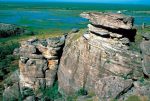
This morning news was released of a date of 65,000 years for archaeological material at the site of Madjedbebe rock shelter in the Jabiluka mineral lease area, surrounded by Kakadu National Park. The site is on the land of the Mirarr people, who have partnered with archaeologists from the University of Queensland for this investigation. It has also produced evidence of the earliest use of ground-stone tool technology, the oldest seed-grinding tools in Australia and stone points, which may have been used as spears. Most fascinating of all, there is the jawbone of a Tasmanian Tiger or Thylacine (which was found across continental Australia during the Ice Age) coated in a red pigment, thought to be the reddish rock, ochre. There is much evidence of use of ochre at the site, with chucks and ground ochre found throughout the site. Ochre is often used for rock art and the area has much beautiful rock art, so we can deduce that these rock art traditions are as old as the occupation of people in Australia, i.e. at least 65,000 years old! The decoration of the jawbone hints at a complex realm of abstract thought, and possibly belief, amongst our distant ancestors – the direct forebears of modern Aboriginal people.

Placing the finds from Madjebebe rock shelter within the larger context, the dating, undertaken by Professor Zenobia Jacobs from the University of Wollongong, shows that people were living at the site during the Ice Age, a time when many, now-extinct, giant animals roamed Australia; and the tiny Homo floresiensis was living in Indonesia. These finds show that the ancestors of Aboriginal people came to Australia with much of the toolkit of their rich, complex lives already in place. This technology, extremely advanced for the time, allowed them to populate the entire continent of Australia, first managing to survive in the hash Ice Age environment and then also managing to adapt to the enormous changes in sea level, climate and vegetation at the end of the Ice Age.
The team of archaeologists working at Madjebebe rock shelter, in conjunction with Mirarr traditional owners, are finding all sorts of wonderful archaeological material, from which they can deduce much rich, detailed information about the lives of the earliest people in Australia. We look forward to hearing more from them in the future. Students who are interested, especially those in Years 4, 5 and 6, can read more about these sites and the animals and lives of people in Ice Age Australia in our resources People Reach Australia, Early Australian Sites, Ice Age Animals and the Last Ice Age, which are covered in Units 4.1, 5.1 and 6.1.


We purchased the soldering kit after our son did the Mirobot workshops at school. He loved the idea of soldering…
Helen, Parent